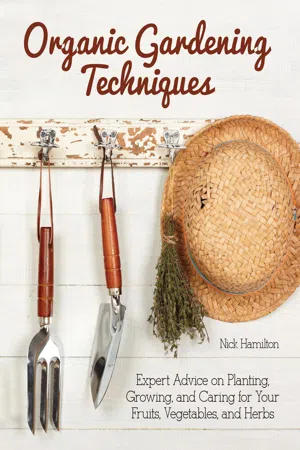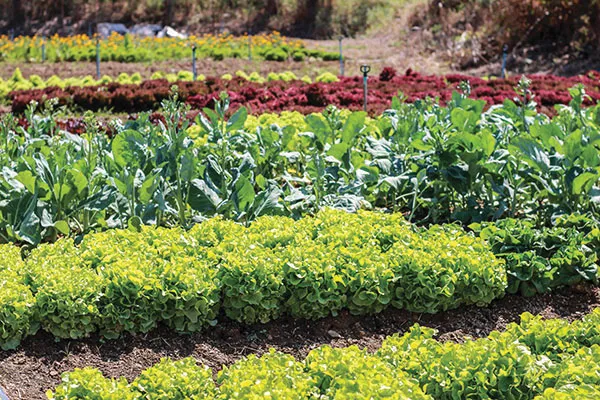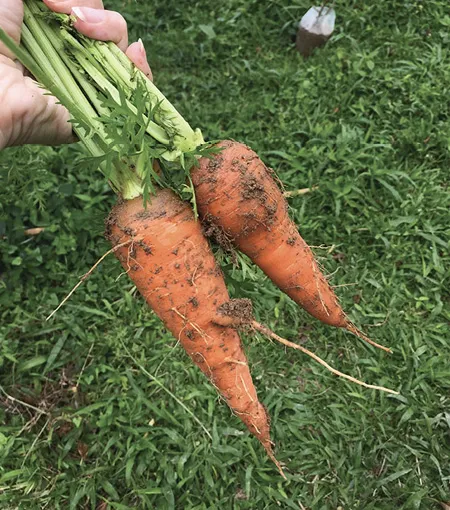
eBook - ePub
Organic Gardening Techniques
Expert Advice on Planting, Growing, and Caring for Your Fruits, Vegetables, and Herbs
This is a test
- English
- ePUB (mobile friendly)
- Available on iOS & Android
eBook - ePub
Organic Gardening Techniques
Expert Advice on Planting, Growing, and Caring for Your Fruits, Vegetables, and Herbs
Book details
Book preview
Table of contents
Citations
About This Book
This comprehensive handbook of organic gardening techniques is full of practical information on sowing and growing fruit, vegetables, and herbs while supporting delicate ecosystems and working without the use of chemicals.
Frequently asked questions
At the moment all of our mobile-responsive ePub books are available to download via the app. Most of our PDFs are also available to download and we're working on making the final remaining ones downloadable now. Learn more here.
Both plans give you full access to the library and all of Perlego’s features. The only differences are the price and subscription period: With the annual plan you’ll save around 30% compared to 12 months on the monthly plan.
We are an online textbook subscription service, where you can get access to an entire online library for less than the price of a single book per month. With over 1 million books across 1000+ topics, we’ve got you covered! Learn more here.
Look out for the read-aloud symbol on your next book to see if you can listen to it. The read-aloud tool reads text aloud for you, highlighting the text as it is being read. You can pause it, speed it up and slow it down. Learn more here.
Yes, you can access Organic Gardening Techniques by Nick Hamilton in PDF and/or ePUB format, as well as other popular books in Biological Sciences & Horticulture. We have over one million books available in our catalogue for you to explore.
Information
Chapter 1: Planning and Preparing for Your Garden

Planning and Rotating Crops
Crop rotation is a subject that often causes confusion, both in terms of its importance to the vegetable grower and what crops are involved. It is a practice that is primarily used in the cultivation of vegetables, and in an ideal world, we would all have a garden that could be easily divided into four equal and adequately sized areas where we could grow all the vegetables we require. Unfortunately, we do not all necessarily have the right setup. The recommendations given are therefore to be viewed as the ideal, but they are not set in stone. Individual gardeners can do only the best they can in their individual situations, which is often not the perfect scenario.
Why Rotate Crops?
There are two main reasons for rotating crops; both apply to a situation in which the same crop is grown in the same place year after year. The first reason is to help in the control of pests and diseases, while the second concerns the nutrient levels of the soil. If the same crop is grown on the same piece of ground year after year, the likelihood that the crop will become badly infected with pests or diseases specific to that crop is vastly increased. Moving the crop each year prevents a buildup of soil-borne pests and diseases that may affect each crop grown. Most of these pests and diseases will not last in the ground long enough to reinfect the crop when it is grown there again.
The grouping of plants is critical, as each group will contain plants that suffer from similar pests and diseases and also have similar nutrient requirements. Therefore, to avoid a crop being infected with a pest or disease specific to that type, there should not be a similar crop from the same group coming onto that plot in the following year. If you are implementing a four-year crop rotation, the groups are as follows:

To minimize possible reinfection, a four-year crop rotation is the ideal solution. This involves dividing the vegetable plot into four equal parts, so that in the first year one of each of the crop groups can be grown in each plot. In the second year, each group is moved around to the next plot, then the same move again in the third year, and so on, so that in the fifth year all the groups are in the plots in which they originally started during year 1. The cycle then starts all over again.
If permanent crops are also being grown, such as soft fruit or rhubarb, these can be kept in a completely separate area and the four-year plan rotated around them. An alternative option would be to incorporate the permanent crops into your plan so that each group is rotated only over a three-year period, as one of the plots will be permanent. This would alter the vegetables into the following groups:

As you can see, Group 4 is divided between Groups 2 and 3.
Catch Crops
These vegetable groups should be used as a fairly accurate guide, but not as an unalterable list. With the longer-maturing crops, such as cabbages, broccoli, kale, and potatoes, it is possible to grow what are called “catch crops” between them. These crops may be from a different vegetable group to the one being grown, but their pest and disease implications will be negligible as they are quick-maturing crops and are harvested before they can affect the growth of the main crop. A catch crop does not have to fit into the crop rotation plan, as it is in the ground for such a short space of time that its impact is minimal, although its inclusion should always be in the overall growing plan. Catch crops can be vegetables such as lettuce, radish, scallion (green onion), arugula (rocket), spinach, and a host of mini or baby vegetable varieties as well as multi-sown onions, beet (beetroot), leek, carrot, turnip, and kohlrabi.
Planning Your Crops
It is important during the cold winter months to sit back with a pile of seed catalogs and plan what is to be grown in the season ahead. This will ensure that all the productive ground is utilized to its best potential and that maximum cropping is achieved. The overall plan of where crops will be planted in the vegetable area and how much needs to be grown—as well as which crops will follow once one has been harvested—must also fit with the space allocated for each group of vegetables within the crop rotation plan. If this all sounds somewhat complicated and confusing at this stage, it is nothing compared to the potential mayhem caused by not knowing what to plant where, which crop should follow the one just harvested, and ending up with an overabundance of one vegetable that you cannot use.
It is important first to look at the space available and divide it into four equal parts so that the best crop rotation can be implemented. Next, sit down and look at the available crops for each section before deciding what to grow. There may be an excellent source of organic fruit and vegetables to buy in your locality and hence no need to take up valuable space growing vegetables that are cheap to buy when the more expensive or less easy-to-obtain vegetables could be grown in that space instead. Why grow a garden full of cheap-to-buy organic potatoes and then buy overpriced corn, cucumbers, and tomatoes from the supermarket?

Radishes can serve as a quick catch crop between longer-maturing crops.
The next concern is to ensure that all of the crops do not mature at once. My philosophy is “little and often” where vegetables are concerned. If I have allocated a row of carrots in the roots area of the productive garden, I never sow the complete row all at once. In this way, the carrots mature at a nice even rate and can be harvested fresh and sweet. They will not have to sit in the ground, waiting until they are needed, where they may become tough, corky, and tasteless. I like to apply this principle to most vegetables I grow. An exception is the fruiting vegetables that just keep producing their harvest throughout the season, such as tomatoes, melons, cucumbers, peppers, eggplant (aubergine), summer squash (marrow), zucchini (courgette), and the like. Green (runner), French, and fava (broad) beans, however, can be manipulated so that their crops also extend over a longer season. This is done by planting early and following with two more plantings, one as a main crop and one to follow at the end of the main-crop season. This usually means we can have green (runner) and French beans from the end of June right through until the end of October.

Sowing and harvesting a crop at different times ensures a constant supply of fresh vegetables.
Vegetable growing is most certainly not just about tossing a few seeds in and harvesting when they mature. To do it successfully, it is important to plan sufficiently, allowing for the odd disaster along the way that may alter the pla...
Table of contents
- Introduction
- Chapter 1: Planning and Preparing for Your Garden
- Chapter 2: Preparing the Soil and Planting
- Chapter 3: Organic Growing Methods
- Chapter 4: Caring for Your Crops
- Chapter 5: Produce Storage and Off -Season Maintenance
- Chapter 6: DIY Projects for Your Garden
- Chapter 7: A Look at Barnsdale Gardens